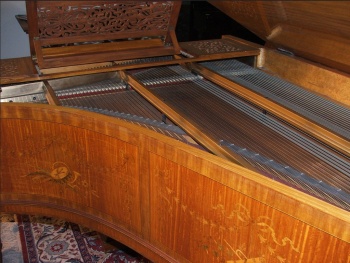Thanks,
"Mr. Locker" was in figuring that your first name was _DJ_ and thus your entire name might be "_DJ_ Locker", a reference to the euphimism for death by drowning, as in:
"Davy Jones' Locker, also Davy Jones's Locker, is an idiom for the bottom of the sea: the state of death among drowned sailors and shipwrecks. It is used as a euphemism for drowning or shipwrecks in which the sailor(s)'s and/or ship(s)'s remains are consigned to the bottom of the sea (to be sent to Davy Jones's Locker)." -from Wikipedia on Davy Jones' Locker
I don't know about Dynaudios, but your setup looks quite serious, indeed. All of these presets are fairly individual per each of our hardware, from speaker position, orientation, strength, etc. I found that I get a much more 'believable' stereo image by having my main speakers facing upwards, which makes them more omnidirectional, much like a grand's horizontal soundboard. My particular setup has Emotiva Stealth8s and AirMotiv4s flanking my 1885 piano - the wide speaker span is why I have to narrow the reproduction width in presets, but wouldn't account for a sound sitting to the right of center. Here's my setup as per a month or so ago, with some minor tweaks having been done since then:
https://goo.gl/photos/mZ6UywoFz79DXAMr9
Dynamics, volume, and velocity curve setup has been a continual tweaking challenge for me.
I turned on the EQ settings briefly, and just wondered if they were your choice (I guess not).
I have not been using reverb much, but have been toying with adding Delays to emulate cabinet resonance and metal-interactions resonance. For example, this is an excerpt from a note that I once sent, about Delays and use of more than one:
"Delay[s]: I have been experimenting with the Delay function as a way to add 'case resonance' - the reflectivity that you get from within the piano's case. I ended up using two separate delays: the first to add some warmth and woodiness, and the second to add a metallic tone, as you hear from what may be interactions with the iron harp and strings themselves. For the 'Woody Case resonance', I set the mix to 20%, time to 20ms, feedback to 5%, and tone to -0.30. The first three help broaden the sound, spreading it a bit generally across the virtual piano, so the treble and bass keys don't have too much precision in the stereo field. The woodiness comes from choosing the tone to be a bit low - I used -0.3 here, listening to the Grotrian videos. I like a wee bit of feedback of the delayed tones, thus choosing 5% (better than 0, and better than 15, at least to my ears). Also to my ears, more than 30 ms delay becomes 'too obvious', and 50 ms was definitely too echo-ey. For the second "Iron Harp and Metal Strings resonance", I used a Tone of +0.20, but reduced the Mix to 18%, the Time to 18 ms, and the Feedback to 3%, as the positive Tone values seem more obvious to hear than the negative ones. Any more and things became too tine-like, but this added just a bit more of a nasal aftertone, as I used for the Tone setting when modeling my old Steinway at home. I'd like to hear people's impressions on how to best utilize this "Tone" setting of the Delay function."
...perhaps you might play with this some, or give me some feedback on whether you think that this is helpful or not as a concept.
-David
- David
